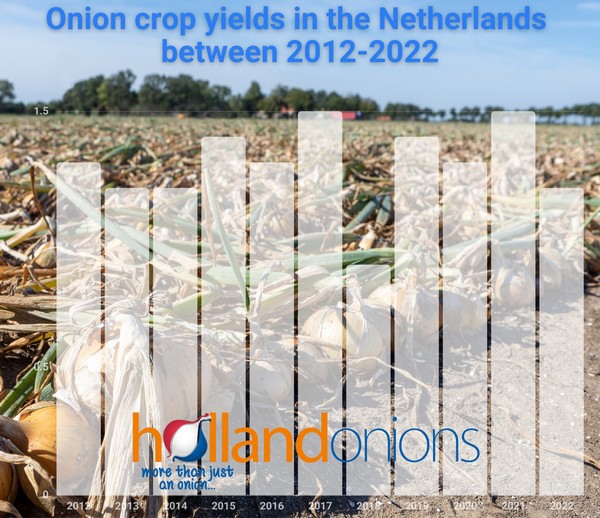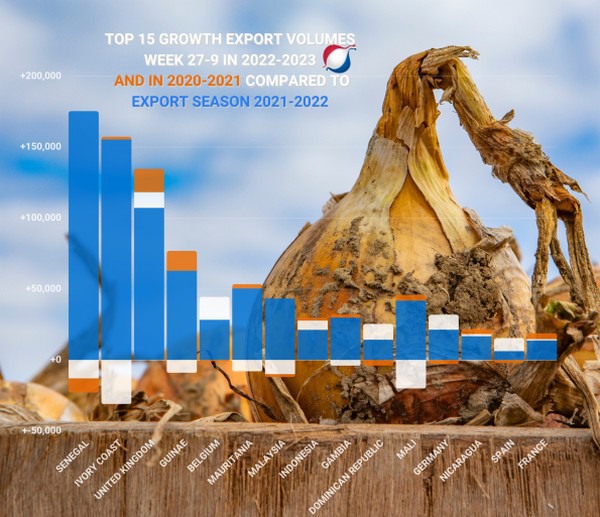For Dutch onions, the 2022-2023 export season will undoubtedly be remembered as a historic one, says the Holland Onion Association. It will not reach a record, volume-wise, but in terms of value, Dutch onion export sales could well, for the first time ever, top €500 million.
Never before have onion prices risen so much, so quickly. In the Netherlands, gross crop yields were down 300,000 tons from the last export season; there were a million tons fewer onions in Europe and significantly lower yields elsewhere due to extreme weather conditions and less use of expensive fertilizers.

Record amounts
Dutch onions are currently selling for record amounts. Never before in this millennium has so much been paid for these yellow onions. That is (finally) good news for Dutch growers. There's an old saying that trade earns more on a quarter than a dime. That is the case with the 2022 onion harvest.
Lower gross harvest
In 2022, 17% fewer seed onions were harvested than the year before. According to the recently published final CBS harvest estimate, those onions' 2022 gross yield was 1.2 million tons. While this is the lowest yield since 2019, it is similar to 2013 and 2014. A million tons of yellow and 200,000 million tons of red seed onions were harvested, with 268,000 tons of onion sets being harvested.
The final total gross yield per ha thus remained almost the same as the 44.5 tons/ha harvest estimate. However, the yellow-to-red onions ratio was adjusted slightly. The first estimate for yellow onions was 44.5 tons per hectare; it ended up at a ton more: 45.5 tons. That, while the yield of red onions dropped from 42.9 tons to 40 tons/ha. The gross yield difference between yellow and red was thus 5.5 tons per hectare or 12% fewer kilograms.
Global onions yield stagnation
Climate change and less available agricultural land have caused onion yields to stagnate worldwide. Occasional local shortages are thus more likely to occur. That while per capita consumption has grown exponentially. "Twenty years ago, the average annual consumption was eight kilograms per person," says Dutch onion export Gijsbrecht Gunter.
"That's now 13kg and could reach 20 kilograms by 2050." He points out that of global onion production (106 million tons), some 92% is destined for local markets. So, the total export market is actually only eight percent or about 8.5 to nine million tons. Dutch onions account for 20% of that.

Different proportions
According to Gunter, that increased consumption and decreased yields offer chances for the Netherlands. He expects rising demand from Asia and Africa in the sales season's first months. "Ten years ago, the first and second half of that season's volume ratio was 40-60. That's now completely reversed to 60-40 and may even reach 70-30," he concludes.
Two-thirds of the race run
At two-thirds of the current export season, total exports seem to lag seven percent from last season. They stand at over 935,000 tons, so the top three ranking countries have changed since last season. Export growth to Senegal and Ivory Coast lags unusually far behind, while exports to Great Britain remain unprecedentedly high.
Those have even increased by almost 12,000 tons to 100,000+ tons. The growth decline in Ivory Coast and Senegal is all thanks to the exceptionally high prices. In early January, a 25 kg bale of Dutch onions sold for about €23 on the Senegalese market. That is a very hefty price for people who often have only a few dollars a day to spend.
Skyrocketing cost price
It costs Dutch onion growers' around €16/100kg to cultivate an average yield of 55 tons per ha, dry from the shed. Add roughly €12 for processing due to the high energy prices to that. That includes packaging and transport from grower to processor to port. With average export costs per reefer container export costs being about €22, Dutch onions simply cannot arrive at their international destination for less than €50/ton.
Import duties (which vary significantly per destination) and further handling and transport to local market costs must still be added. Thus, Dutch onions' cost price reach close to €0.60/kg. That corresponds to roughly €14/bale, where everything is paid for, but not much is earned. This season's prices prove it is indeed lucrative to grow onions. At these prices, growers can keep being growers.
Top 15, volume shift to Europa
In the top 15 rankings, a shift in the top three is most notable. Other than that, Belgium has moved from eighth to fifth position, already importing 17,000 tons more this season. That is true of most of the Netherlands' neighbors. Poland, Germany, Spain, and Portugal are also well up. Portugal recorded the proportionally largest growth, from just under 440 tons to over 3,600 tons.
Germany climbs from 11.5 to nearly 21,000 tons, and Spain more than doubled its imports compared to last season, thus entering the top 15. The aforementioned European shortage of one million tons of onions means Dutch onions are very popular, especially in the export season's second half.
Another noteworthy development: Israel's (renewed) entrance at number 16, with more than 13,000 tons. Brazil fell just outside the top 20 but still took 8.500 tons. Australia imported ten times as many Dutch onions this season, although that is still only 335 tons, thus only a few containers.
Source: Holland Onion Assocation
